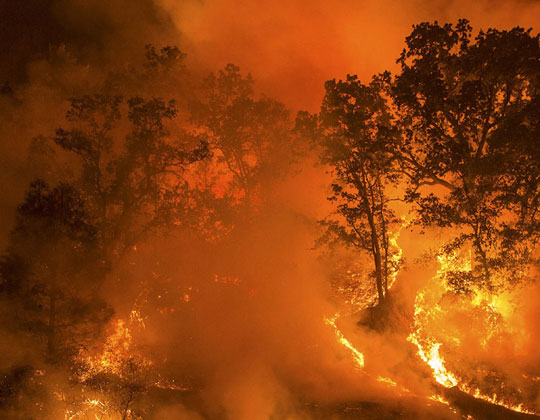2020 was a challenging year with many unprecedented events. The 2020 wildfire season wasn’t an exception with record setting fires across the country. NIFC reported that as of December 23rd, 2020 there had been 57,480 wildfires that have burned 10,357,138 acres. This is almost 4 million more acres burned than the 10-year average and more than double the acreage burned in the 2019 season.
| Year-to-date statistics | ||
| 2020 (1/1/20-12/23/20) | Fires: 57,480 | Acres: 10,357,138 |
| 2019 (1/1/19-12/23/19) | Fires: 49,492 | Acres: 4,576,827 |
| 2018 (1/1/18-12/23/18) | Fires: 55,911 | Acres: 8,582,609 |
| 2017 (1/1/17-12/23/17) | Fires: 65,127 | Acres: 9,563,128 |
| 2016 (1/1/16-12/23/16) | Fires: 62,946 | Acres: 5,437,875 |
| 2015 (1/1/15-12/23/15) | Fires: 60,984 | Acres: 9,937,863 |
| 2014 (1/1/14-12/23/14) | Fires: 63,252 | Acres: 3,585,569 |
| 2013 (1/1/13-12/23/13) | Fires: 46,373 | Acres: 4,306,944 |
| 2012 (1/1/12-12/23/12) | Fires: 67,326 | Acres: 9,208,193 |
| 2011 (1/1/11-12/23/11) | Fires: 72,508 | Acres: 8,642,298 |
| 2010 (1/1/10-12/23/10) | Fires: 68,598 | Acres: 3,379,874 |
| 10-year average Year-to-Date | ||
| 2010-2019 | Fires: 61,203 | Acres: 6,712,681 |
Source: National Interagency Fire Center (NIFC)
California First to Raise the Alarm
On March 22, California Governor Gavin Newsom declared a state of emergency due to critical fire weather conditions brought by dry conditions, near record heat, and a mass die-off of trees throughout the state.
Wildfires in California burned a record setting 4.2 million acres with 5 of the states top 20 largest wildfires and 6 of the states most destructive fires occurring this year. The staggering number of acres burned are the most in a single year since CalFire began keeping records, and more than the last three years combined. These wildfires damaged or destroyed approximately 10,500 structures and killed 31 people.
All but one of these record setting fires occurred during the “August Lighting Siege.” Over the course of 72 hours, more than 650 wildfires ignited across Northern California. Of these fires, the lightning caused August Complex became the first “giga fire”, burning over a million acres and shattering the previous record by nearly double the amount of acres burned.

Size Comparison – The August Complex Perimeter Repositioned Over the Los Angeles Metropolitan Area
Other States Suffered a Similar Fate
Other states experienced similar wildfire intensity. Almost 700,000 acres burned in Colorado during 2020, including the three largest fires in state history.
The Cameron Peak Fire started on August 13 in the Arapaho and Roosevelt National Forests west of Fort Collins. It became the largest in Colorado’s history after quadrupling in size over Labor Day weekend and making another aggressive run on Oct. 14, burning over 20,000 acres in one day. Before the fire was finally contained it had burned over 208,913 acres.
The East Troublesome Fire, the second-largest blaze in Colorado’s history, moved through some areas at as much as 6,000 acres per hour. The fire eventually consumed 193,812 acres and became the first fire to cross the continental divide.
In Oregon wildfires burned approximately 1 million acres of land, almost double the 10-year average of 557,000 acres. More concerning than the number of acres burned, the second most in state history, was the unprecedented destruction. Only 2 homes were lost to wildfires in Oregon in 2019. In fact over the course of the last 4 wildfire seasons Oregon only lost a combined total of 93 homes. The amount of homes lost in 2020 totaled more than the next 5 most destructive seasons combined, with 4,009 homes lost!
Not to be outdone by its southern neighbor, Washington saw more acres burn in one day than it did in the entirety of the past 12 wildfire seasons. Some 80 fires ignited and burned through nearly 300,000 acres over Labor Day. This includes the Pearl Hill and Cold Springs fires which combined to burn over 410,000 acres and become the largest in the state’s history.
More of the Same in 2021
The last month of 2020 was a precursor of what is to come with several days of Red Flag Warnings for California. As 2021 nears, forecasters predict another year of large fires due to continuous climate change, persistent drought, and La Niña in regions prone to parched vegetation and climbing temperatures. It seems impossible to imagine that we could see records shattered like 2020 but if the past few years have proven, unprecedented wildfire seasons are the new normal.






2 Comments